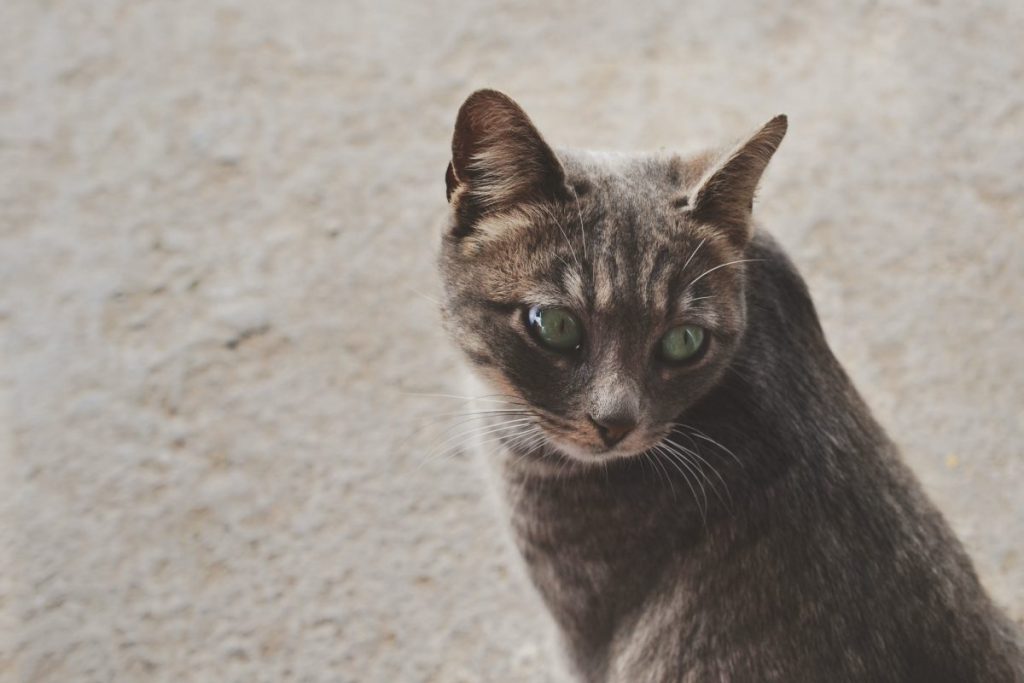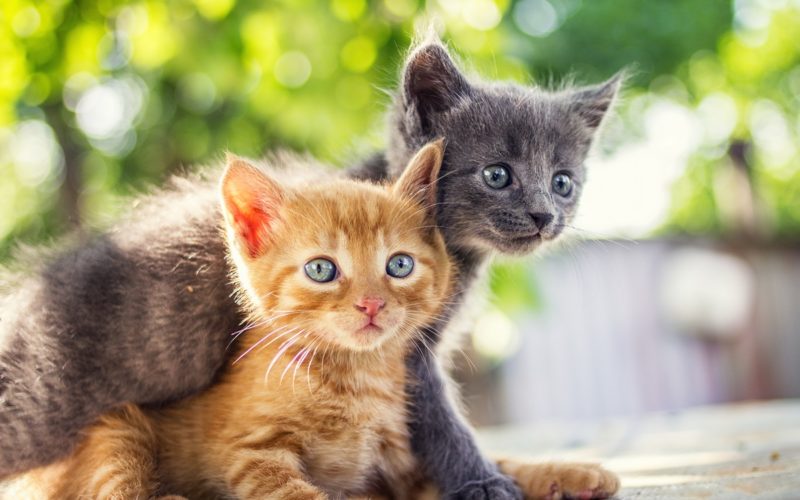There are several different factors that can cause nausea in cats. If the digestive and nervous systems are out of alignment, it often results in nausea; however, each occurrence requires individual attention.
Whether your cat has a bout with vomiting or experiences an upset stomach on occasion, it’s important to know the cause and necessary treatments. Some cases of cat nausea can simply be attributed to indigestion, while others may be indicative of other issues, including food allergies or underlying health problems.
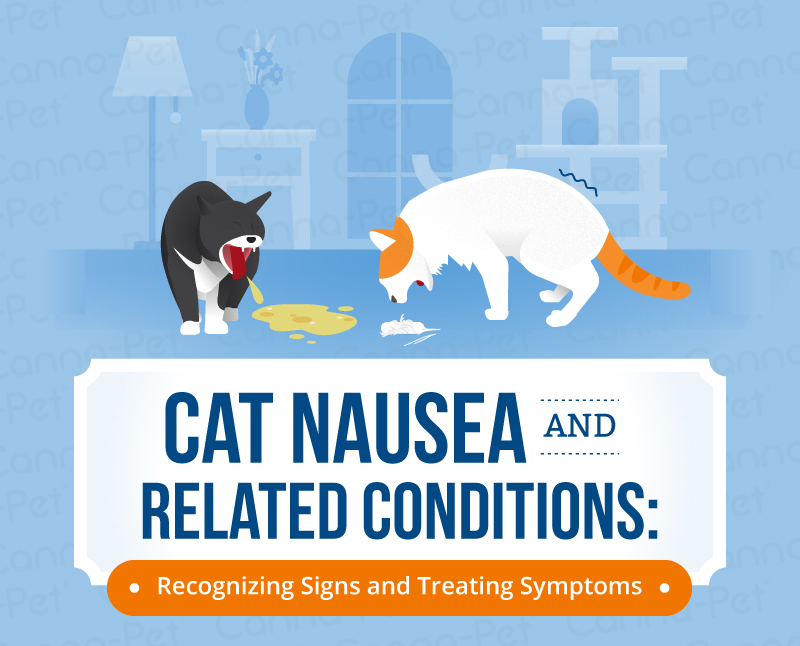
Tell-tale signs of cat nausea may include:
- Panting/heavy breathing
- Drooling
- Frequent lip-licking
- Restlessness
- Retching
- Swallowing
- Trembling/shaking
- Vomiting
- Anxiety and nervous behavior, including vocalization and hyperactivity
The first step in determining your cat’s nausea is assessing recent activities: do you notice that he seems sensitive to the new cat chow you’ve been giving him? If so, it may be a dietary issue. Another common cause for feline vomiting is due to hairballs (scientific name: trichobezoar).
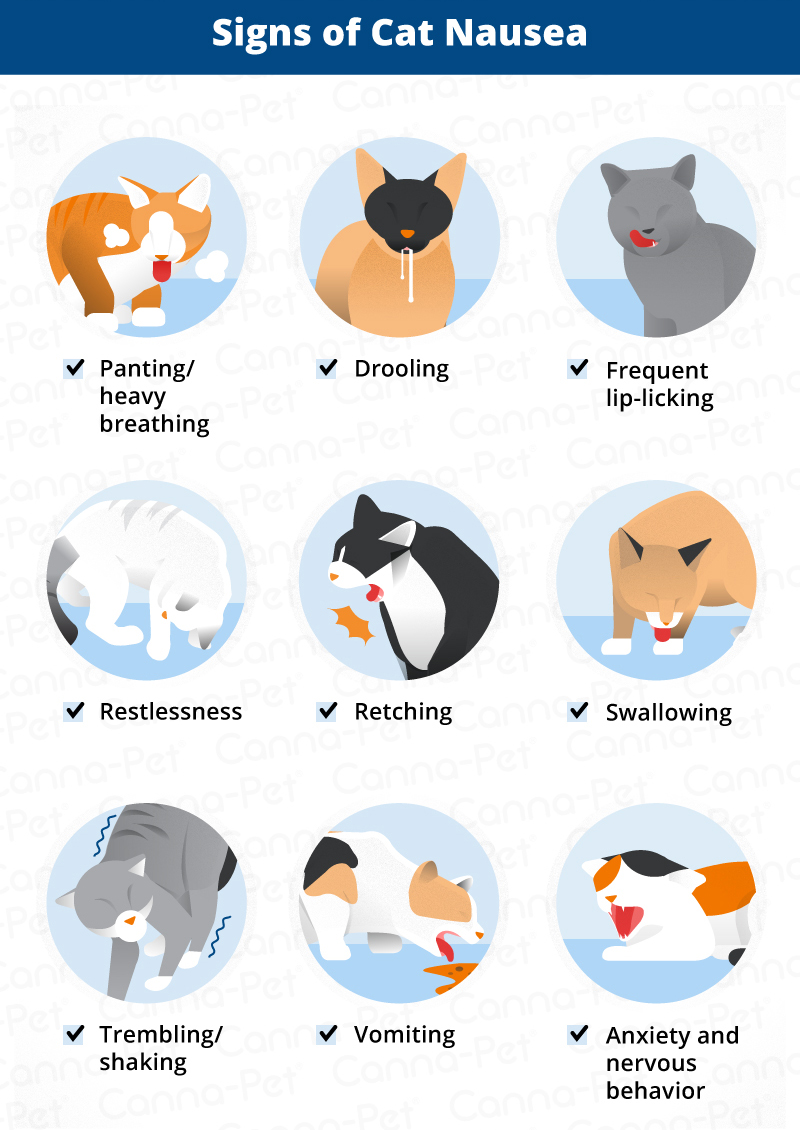
Common Causes of Cat Nausea
For general cases of cat nausea and upset stomach, you may want to consider the following potential causes:
- A sudden change in diet (most common)
- Food allergies
- Hairballs
- Stressful or anxiety-inducing situations (such as car rides or trips to the vet)
- Travel (including cars, airplane flights, or being transported in a crate/carrier)
- A bacterial or viral infection
- Consuming a toxic or poisonous substance
- Illness or chronic condition
- Ingestion of foreign object (e.g., string or small item that could cause blockage)
- Medication side-effects
- Parasites (such as ringworm)

Once your vet has assessed your cat’s health and determined the cause of nausea, it’s important to follow through with any treatments or instructions from your vet. Depending on the cause of vomiting, it’s typically recommended to limit your cat’s food intake; your vet will let you know exactly how long to restrict his regular eating routine.
When it’s time for your cat to resume eating again, experts recommend a bland diet, such as cooked rice and chicken, along with small amounts of water (if your cat has specific food allergies, ask your vet for safe food options appropriate for recovery-time).
Tips for Treating Your Cat’s Mild Stomach Ache & Nausea
Limit food intake: Unlike humans, cats don’t consciously decide to ‘fast’; however, in nature, felines will stop eating until they’re feeling better. On the other hand, domesticated adult cats need some assistance from their pet-parents, as the smell of food may be too tempting – and they eat despite their condition, which may repeat the cycle and lead to vomiting again.
With that said, there are times where the best thing you can do for a cat with a sick tummy is to give it a rest: remove food for a day, or limit it to a small amount (preferably a bland diet such as plain boiled chicken without the skin and rice). Be sure that your cat stays well-hydrated during the fast and has a warm and comfortable place to rest and recover.
Cats should never go longer than a day without eating, so reintroduce foods to them as soon as safely possible. For kittens, fasting for a few hours may alleviate the symptoms of a common case of nausea/vomiting. If you’re concerned about limiting your cat’s food, consult with your vet for more information.

Keep your cat hydrated: As is the case in any mammal, vomiting and diarrhea can lead to a loss in electrolytes and essential fluids. An easy way to check your cat’s hydration level: gently lift the skin over the shoulder and see how quickly it springs back into position. If he’s well-hydrated, it will bounce back right away; however, if he’s dehydrated, it will be delayed.
It’s also important to monitor your cat’s water consumption: in certain instances, drinking water on a bad stomach can lead to vomiting, resulting in additional dehydration. If your cat is displaying these symptoms, give him ice chips to lick on. You may also consider administering unflavored Pedialyte® (a hydrating beverage designed for infants) in a dropper.
Slowly and carefully give him a few drops at a time; this can help prevent further dehydration. If you notice acute cases of dehydration (such as extreme fatigue or incontinence) your cat may be in critical condition. He will require intravenous fluids as administered by a vet, so be sure to contact your clinic immediately.
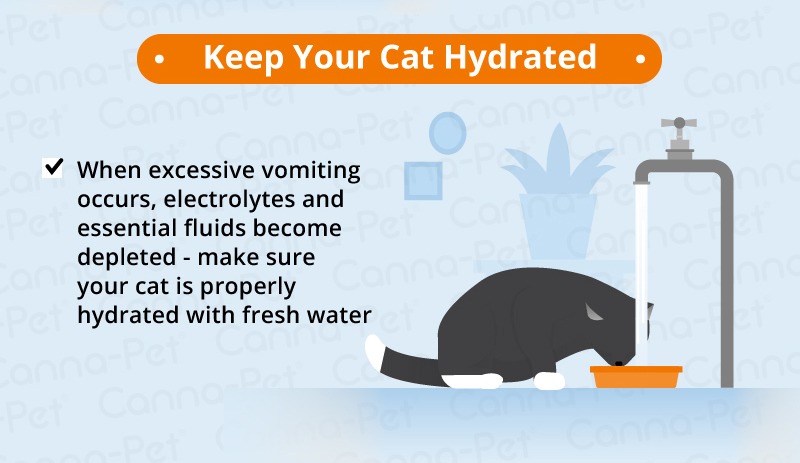
Help with hairballs: As discussed, vomiting is commonly linked to hairballs, in which case certain pet laxatives or hairball treatments may be considered. An easy, at-home remedy includes rubbing a bit of petroleum jelly (Vaseline®) on your cat’s paw; once he licks it off and it passes through his digestive system, it can help him eliminate the hairball naturally. Other food alternatives to try include the oil from a can of tuna, plain canned pumpkin (free of spices; not pumpkin pie mix), or a bit of butter.
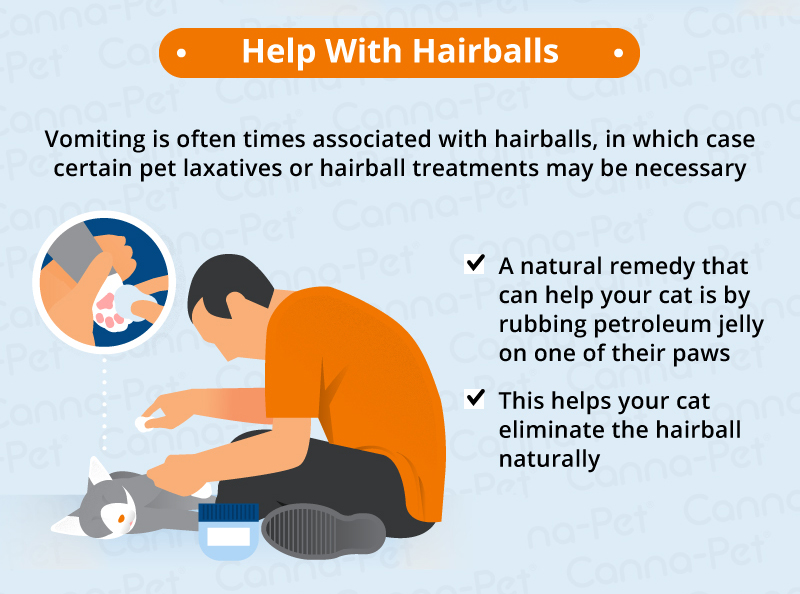
Resuming a regular diet: Once your cat has stopped vomiting and his bowel movements are solid, you can safely resume feeding him at his normal mealtime over the next 3 – 4 days. It’s important to reintroduce food gradually and in smaller portions – avoid any foods that your cat has a known sensitivity to (as mentioned earlier, a bland diet may be helpful for the first few days). Reverting back to your cat’s regular diet too quickly may cause his symptoms to reoccur.
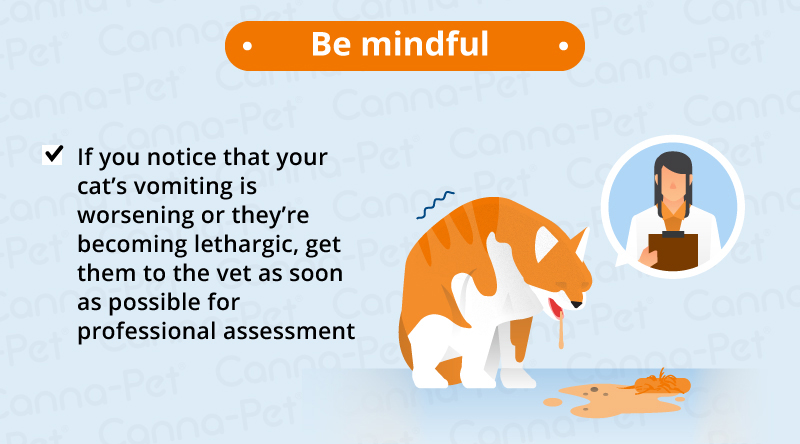
Be mindful: Although there are plenty of home remedies, natural treatments and general good pet-parenting techniques we can practice to treat a mild case of nausea or stomach disturbance, it’s important to monitor your cat’s overall health and behavior. If he shows any signs or symptoms of lethargy, excessive vomiting, loss of appetite, diarrhea/dehydration or appears in pain, it’s essential to see your vet as soon as possible for a professional assessment.
Hairballs: How to Treat & Prevent
One of the most common causes for nausea and vomiting in cats can be linked to hairballs, a naturally-occurring phenomenon that most cats experience. Although an occasional hairball isn’t reason for concern, excessive hairball production and sickness should be addressed promptly.
If your cat displays the following symptoms, contact your vet immediately, as a hairball may result in a life-threatening blockage:
- Ongoing vomiting, retching, gagging, or hacking without producing a hairball
- Lethargy
- Lack of appetite
- Diarrhea
- Constipation
Grooming: An easy way to prevent hairballs is to groom your cat frequently, which simply entails brushing your cat often. By removing excessive hair and dead skin, you can actually improve his digestive health – because cats are self-cleaning animals, they lick (and ingest) dead fur, debris and any microorganisms that may be living on their skin and coat.
If you practice good grooming and notice he’s still coughing up an abnormal amount of hairballs accompanied by vomiting, it’s best to consult your veterinarian for advice. For pet owners who find it difficult to groom their cat (for example, unruly cats or long-haired breeds), you may want to consider the services of a professional groomer.
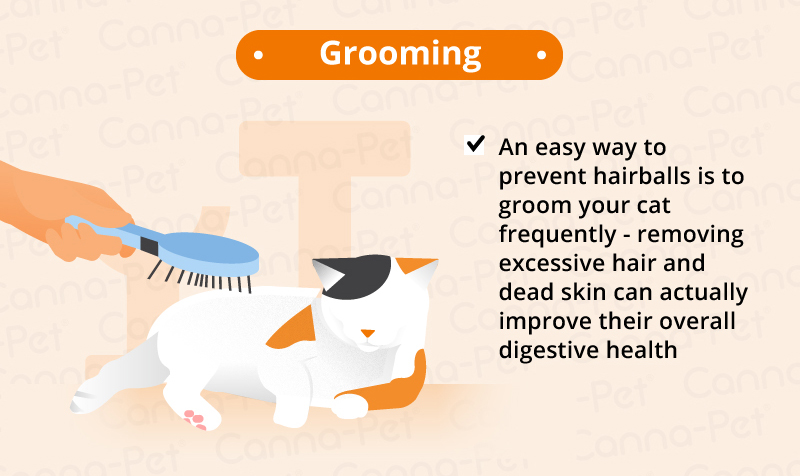
Diet: A fairly simple way to ensure your cat’s hairball production (and nausea) is limited, ‘hairball formula’ cat foods are a great alternative. Featuring specially-formulated ingredients, these high-fiber pet foods are engineered to improve the health of your cat’s coat, reduce shedding, and encourage hairballs to pass naturally through your cat’s digestive tract. Many manufacturers offer these hairball formulas; if you’re not sure where to find them, your local pet store or online retailer can assist you.
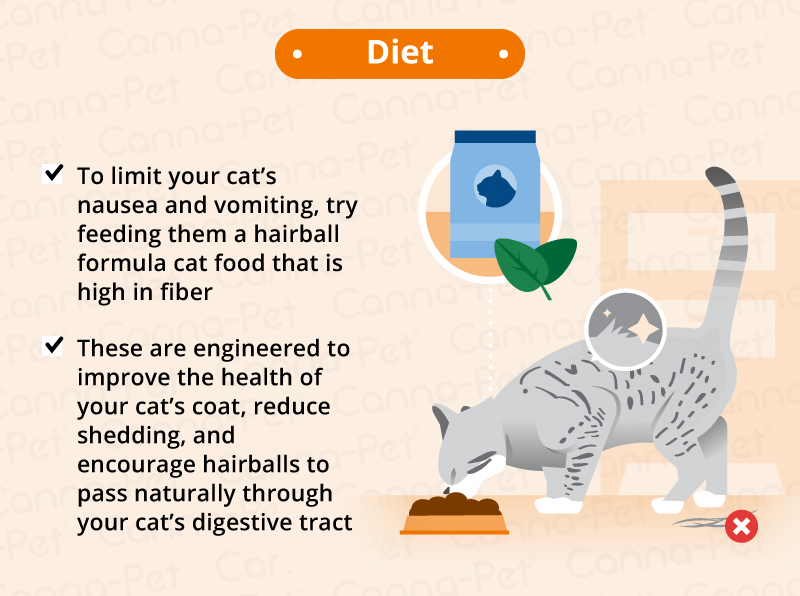
Hairball products: For acute cases of hairballs in your furry feline, you may want to consider a specially-formulated product designed for relief. The majority of these products contain gentle laxatives that allow hairballs to pass more easily through your cat’s digestive system.
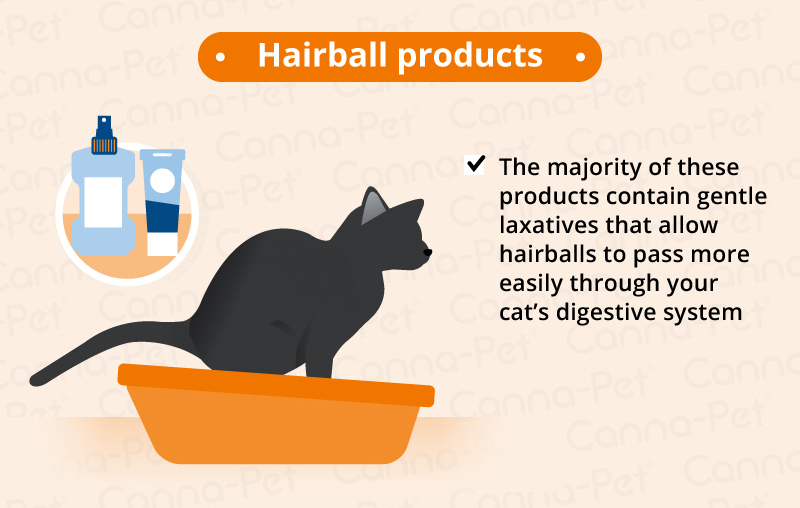
Behavior modification: If you believe your cat may be displaying signs of OCD or compulsive grooming, you may want to engage your furry friend in an alternate activity. When you see him begin to groom obsessively, distract your cat with a favorite toy or encourage another fun form of play – in addition to behavior modification, this can also deepen the bond between you and your pet and reduce anxiety.
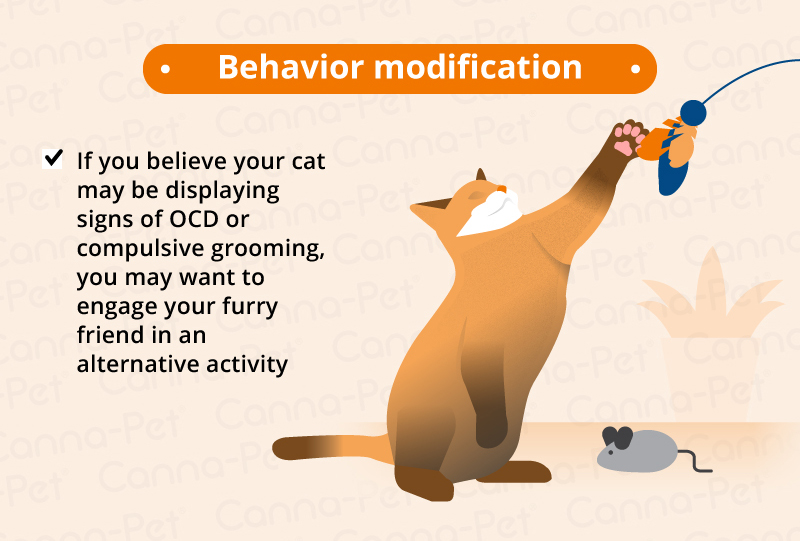
Motion Sickness: Timing is Everything
Cats are frequently known to experience motion sickness during travel. Most cats do not adapt to change easily. Therefore extreme changes in their surroundings – including trips in the car or plane – can be the source of great stress and anxiety to your beloved pet.
Common symptoms may include vocalizing, drooling excessively and even panting on occasion. Other signs your cat may display include shaking, restless behavior and vomiting, as well as urinating or making a bowel movement in their crate.
One of the most helpful things you can do to help your cat overcome motion sickness is to introduce them to traveling early on, if at all possible. Cats that begin traveling at a young age are more easily acclimated to the experience, as it allows you as a pet parent to reinforce trips as a positive experience.
Be sure to make your cat as comfortable as possible during any trip – in addition to protecting them from harm, crates or carriers are essential to their feeling of safety and well-being. You may wish to put a favorite toy or blanket in their crate and reassure them if they show signs of anxiety or distress. Short trips in the car are also a great way to get your cat used to traveling. Music therapy (such as listening to mellow classical music) has also proven effective in relaxing anxious kitties.
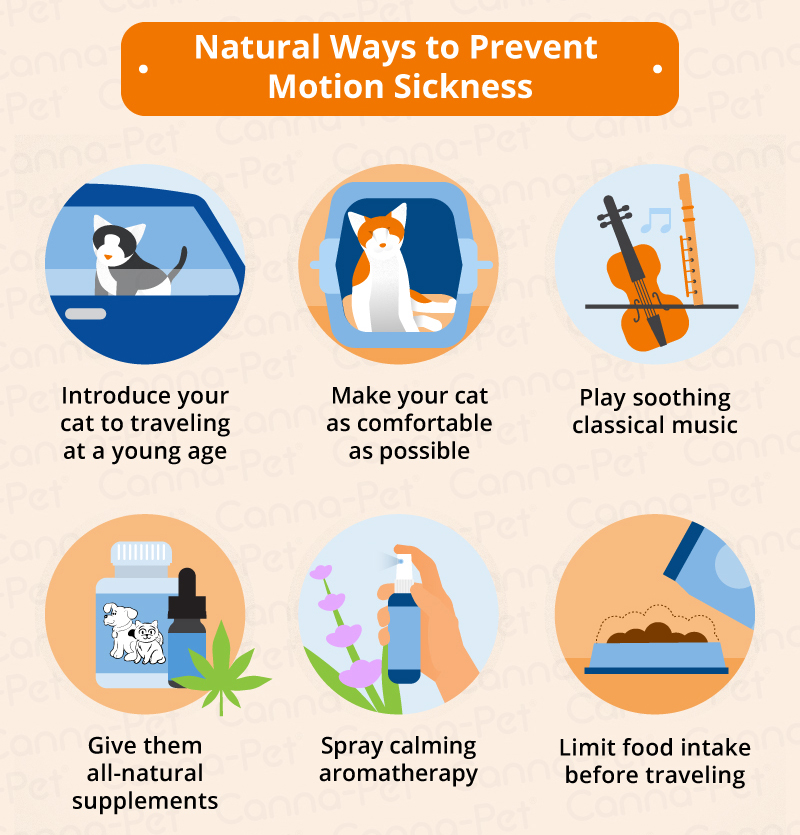
Additionally, you may consider homeopathic methods including aromatherapy – natural scents such as lavender may soothe your cat’s nerves. There are also all-natural supplements such as Canna-Pet that can be used to calm your cat before a long journey. As in any case, be sure to check with your vet before administering any type of treatment, even if it’s labeled ‘all-natural’ – it’s the best way to ensure your cat’s safety.
If your cat experiences motion sickness, a safe rule of thumb is to limit food intake before any trips. When traveling with your feline companion, it’s best to feed him well in advance to avoid vomiting or other symptoms of nausea.
There are also a number of commercial veterinary diets that are effective at controlling motion sickness. As you may have guessed, asking your vet plenty of questions is helpful when developing an effective feeding/care routine for motion sickness-prone cats. You may want to explore natural remedies with your vet for severe cases of travel-induced anxiety or nausea.
Emotional Factors: Recognizing Stress and Anxiety
If you notice your cat eats quickly and vomits shortly after meals, you may want to consider his emotional well-being. Stress and anxiety can also be linked to your cat’s rapid eating patterns and stomach issues.
Rescue cats are especially prone to such behavior, as they may have had to compete for food in the shelter or on the street, especially if they are feral. If you think that your cat’s eating habits or subsequent nausea is due to a behavioral issue, it’s best to consult with your veterinarian for insight and advice.
There are certain behavioral techniques that can help ease your pet’s anxiety, which will in turn help him establish a normal eating routine (while diminishing symptoms of nausea and upset stomach).
Chronic Conditions & Disease
If your cat is experiencing recurring bouts of vomiting, diarrhea/constipation or other chronic digestive issues, it may be indicative of conditions such as:
- Fungal/bacterial infections
- IBD (inflammatory bowel disease)
- Motility disorders (i.e., gastric abnormalities)
- Cancer
- Metabolic diseases (such as kidney failure, liver failure or hyperthyroidism)
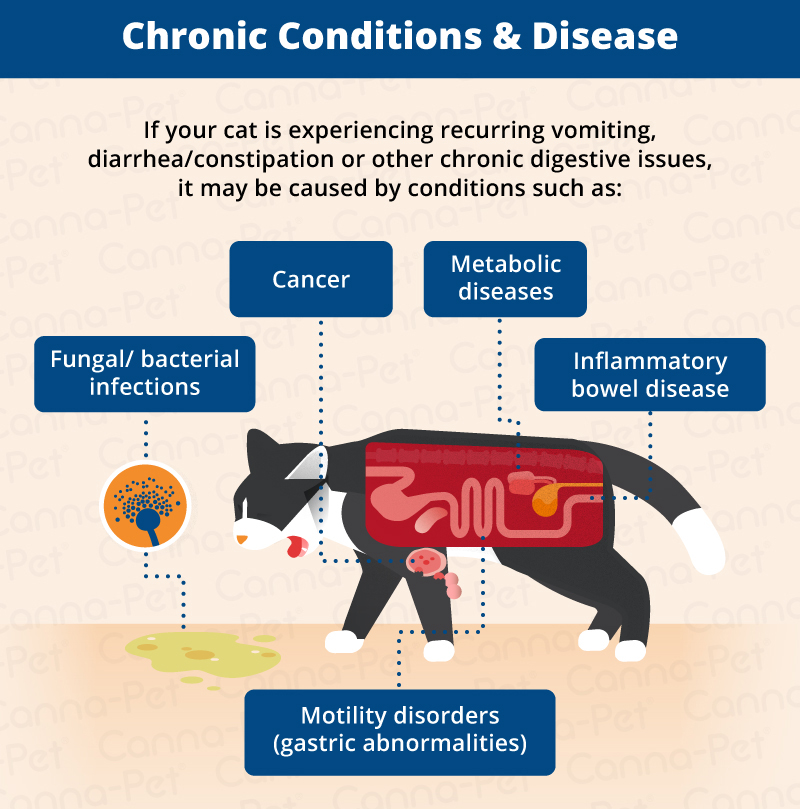
Although most pet owners don’t want to assume the worst-case scenario, it’s important to act quickly if you recognize a pattern of chronic symptoms. If you observe persistent nausea, vomiting, excessive hacking/retching or other related warning signs, contact your veterinarian immediately for a complete examination. By taking a proactive role in your cat’s health, you can ensure his happiness and well-being for years to come.
Sources:
- Wilson, Julia. “Nausea in Cats – Causes, Symptoms and Treatment.” Cat World, Accessed 6 Dec. 2016. www.cat-world.com.au/nausea-in-cats.html.
- Miksen, Chris. “A Comprehensive View of Cat Nausea.” The Nest, 21 Nov. 2017, Accessed 6 Dec. 2016. www.pets.thenest.com/comprehensive-cat-nausea-10784.html.
- “6 Most Common Cat Health Problems.” WebMD, Accessed 6 Dec. 2016. www.pets.webmd.com/cats/6-most-common-cat-health-problems#1.
- “Vomiting Cat – Normal or a Concern?” Vetwest Animal Hospitals, 27 Nov. 2014, Accessed 6 Dec. 2016. www.vetwest.com.au/pet-library/vomiting-cat-normal-or-a-concern.
- “Is Your Cat Sick or Stressed Out?” PetMD, Accessed 6 Dec. 2016. www.petmd.com/blogs/thedailyvet/jcoates/2011/feb/is_your_cat_sick_or_stressed_out-10713.

